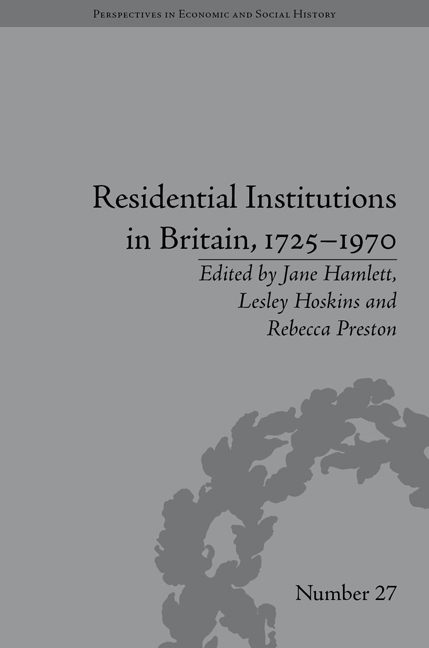Book contents
- Frontmatter
- Contents
- Acknowledgements
- List of Contributors
- List of Figures
- Introduction
- 1 Viewing the Early Twentieth-Century Institutional Interior through the Pages of Living London
- 2 ‘French Beef was Better than Hampstead Beef’: Taste, Treatment and Pauperism in a London Smallpox Hospital, 1871
- 3 From Asylum to Mental Hospital: Gender, Space and the Patient Experience in London County Council Asylums, 1890–1910
- 4 Refuge or Prison? Girls' Experiences of a Home for the ‘Mentally Defective’ in Scotland, 1906–1948
- 5 Paupers and their Experience of a London Workhouse: St Martin-in-the-Fields, 1725–1824
- 6 ‘A Veritable Palace for the Hard-Working Labourer?’ Space, Material Culture and Inmate Experience in London's Rowton Houses, 1892–1918
- 7 ‘The Place was a Home from Home’: Identity and Belonging in the English Cottage Home for Convalescing Psychiatric Patients, 1910–1939
- 8 ‘The Father and Mother of the Place’: Inhabiting London's Public Libraries, 1885–1940
- 9 ‘Discipline with Home-Like Conditions’: The Living Quarters and Daily Life of the Women's Army Auxiliary Corps in First-World-War Britain and France
- 10 Halls of Residence at Britain's Civic Universities, 1870–1970
- Notes
- Index
9 - ‘Discipline with Home-Like Conditions’: The Living Quarters and Daily Life of the Women's Army Auxiliary Corps in First-World-War Britain and France
- Frontmatter
- Contents
- Acknowledgements
- List of Contributors
- List of Figures
- Introduction
- 1 Viewing the Early Twentieth-Century Institutional Interior through the Pages of Living London
- 2 ‘French Beef was Better than Hampstead Beef’: Taste, Treatment and Pauperism in a London Smallpox Hospital, 1871
- 3 From Asylum to Mental Hospital: Gender, Space and the Patient Experience in London County Council Asylums, 1890–1910
- 4 Refuge or Prison? Girls' Experiences of a Home for the ‘Mentally Defective’ in Scotland, 1906–1948
- 5 Paupers and their Experience of a London Workhouse: St Martin-in-the-Fields, 1725–1824
- 6 ‘A Veritable Palace for the Hard-Working Labourer?’ Space, Material Culture and Inmate Experience in London's Rowton Houses, 1892–1918
- 7 ‘The Place was a Home from Home’: Identity and Belonging in the English Cottage Home for Convalescing Psychiatric Patients, 1910–1939
- 8 ‘The Father and Mother of the Place’: Inhabiting London's Public Libraries, 1885–1940
- 9 ‘Discipline with Home-Like Conditions’: The Living Quarters and Daily Life of the Women's Army Auxiliary Corps in First-World-War Britain and France
- 10 Halls of Residence at Britain's Civic Universities, 1870–1970
- Notes
- Index
Summary
The Material Environments of Martial Femininity
In December 1918, the Women's Army Auxiliary Corps (WAAC) chose for its official Christmas card a drawing by a member of the lower ranks, which depicted a uniformed auxiliary worker with the hutted campsite of her unit in the background. The selection of this image was not coincidental. Between 1917 and 1919 the living quarters of the WAAC became an iconic emblem of the organization, represented in a series of press reports, photographs and recruiting images, followed by several watercolours and oil paintings. Such widespread and varied portrayal indicates the centrality of these lodgings in the public image and collective identity of the corps. In this respect the WAAC was unique among women's war organizations. Whether they worked for the munitions industry, public transport, the Land Army or the auxiliary services of the navy and the air force, women war workers were usually identified in visual representations by the places, tools and products of their labour, rather than their accommodation.
This chapter explores the living quarters and conditions of the WAAC to explain how and why they became such a defining feature of the corps. It starts by investigating the ideological significance of women's military accommodation to uncover the role which WAAC housing played in integrating the first female corps into the masculine world of the army.
- Type
- Chapter
- Information
- Residential Institutions in Britain, 1725–1970Inmates and Environments, pp. 141 - 154Publisher: Pickering & ChattoFirst published in: 2014



